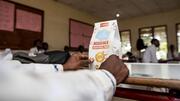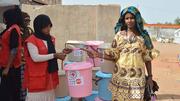-
Country Pages
-
Asia y el Pacífico
- Afganistán
- Bangladesh
- Bhután
- Camboya
- China
- India
- Indonesia
- República Islámica del Irán
- República Democrática Popular Lao
- Malasia
- Maldivas
- Mongolia
- Myanmar
- Nepal
- Pakistán
- Estado Independiente de Papua Nueva Guinea
- Filipinas
- Sri Lanka
- Tailandia
- Timor Oriental
- Vietnam
-
Europa Oriental y Asia Central
- Albania
- Armenia
- Azerbaiyán
- Belarús
- Bosnia y Herzegovina
- Georgia
- Kazajstán
- Oficina de Kosovo
- Kirguistán
- República de Moldova
- Macedonia del Norte
- Serbia
- Tayikistán
- República de Türkiye
- Turkmenistán
- Ucrania
- Uzbekistán
-
Estados Árabes
- Argelia
- Yibuti
- Egipto
- Iraq
- Jordania
- Líbano
- Libia
- Marruecos
- Omán
- Palestina
- la República Federal de Somalia
- Sudán
- República Árabe Siria
- Túnez
- Yemen
-
África Oriental y Meridional
- Angola
- Botswana
- Burundi
- Comoras
- República Democrática del Congo
- Eritrea
- Eswatini
- Etiopía
- Kenya
- Lesotho
- Madagascar
- Malawi
- Mauricio
- Mozambique
- Namibia
- Rwanda
- Seychelles
- Sudáfrica
- Sudán del Sur
- República Unida de Tanzanía
- Uganda
- Zambia
- Zimbabwe
-
América Latina y el Caribe
- Argentina
- Estado Plurinacional de Bolivia
- Brasil
- Chile
- Colombia
- Costa Rica
- Cuba
- República Dominicana
- la República del Ecuador
- El Salvador
- Guatemala
- Haití
- Honduras
- México
- Nicaragua
- Panamá
- Paraguay
- Perú
- Uruguay
- República Bolivariana de Venezuela
- Caribe (multinacional)
-
África Occidental y Central
- Benin
- Burkina Faso
- Cabo Verde
- Camerún
- República Centroafricana
- Chad
- Congo
- Costa de Marfil
- la República de Guinea Ecuatorial
- Gabón
- Gambia
- Ghana
- Guinea
- Guinea-Bisáu
- Liberia
- Malí
- Mauritania
- Níger
- Nigeria
- Sao Tomé y Príncipe
- Senegal
- Sierra Leona
- Togo
-

UNFPA Gambia
A least developed country, The Gambia has reduced maternal mortality, but further progress is needed. Limited access to contraceptives and the prevalence of child marriage also remain key challenges. Active in the country since 1972, UNFPA helps strengthen capacities to provide reproductive health care, including emergency obstetric and family planning services. With HIV prevalence edging up, UNFPA has assisted with collecting national data mapping the epidemic’s socio-economic differences and applying new information to policy-making. Programmes also back the implementation of the national gender and women’s empowerment policy.
Población
- Población de 0 a 14 años, en porcentaje
- Población de 15 a 64, años, en porcentaje
- Population aged 65+
Salud sexual y reproductiva
- Nacimientos atendidos por personal sanitario calificado
Planificación familiar
- Modern method
Educación
Gender, Rights, and Human Capital
Prácticas nocivas
Population Pyramid
Esperanza de vida
Total fertility rate
Noticias
“Estamos cambiando las cosas”: la lucha contra la pobreza menstrual y la mutilación genital femenina en Gambia
BASSE (Gambia) – “Los problemas suelen empezar con la primera menstruación de las niñas”, afirma Ndeye Rose Sarr,...
Los kits de higiene femenina ayudan a las mujeres y las niñas en las comunidades vulnerables afectadas por la pandemia en Gambia
A medida que la pandemia de COVID-19 envuelve gran parte del mundo, las autoridades sanitarias de Gambia están...


Redes sociales
Tweets from UNFPATürkiye